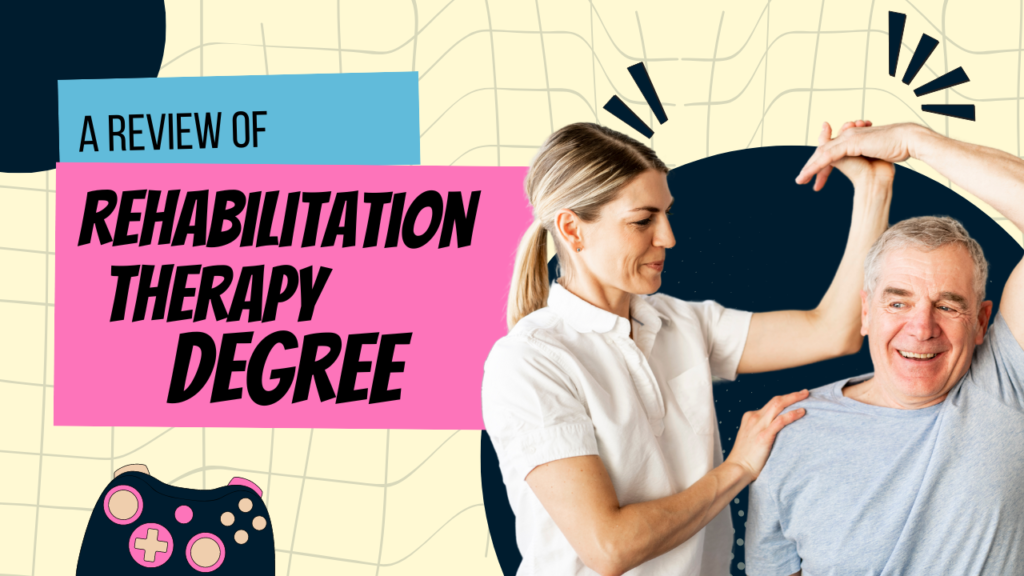Rehabilitation Therapy Degree: What is it?
A rehabilitation therapy degree equips students with the knowledge and skills to assist patients in recovering or adapting following injuries, acute medical conditions, or disability diagnoses. Rehabilitation therapists collaborate one-on-one with patients, getting to know their unique needs while establishing trusting relationships.
Together, they work diligently on customized treatment plans aimed at regaining mobility and independence in daily life activities like walking, self-care, work, recreation, and socializing. With compassion and clinical expertise, rehabilitation therapists help patients manage both chronic and acute pain to improve comfort.
The ultimate goal is empowering patients to persevere through recovery challenges so they can thrive again emotionally and physically at home and in their communities.
Rehabilitation Therapy Degree

Rehabilitation therapy degrees are available at the associate, bachelor’s, master’s, and doctoral levels. Students take courses in areas like biology, psychology, ethics, and specific rehabilitation topics.
Programs blend classroom instruction with clinical rotations where students get hands-on experience in facilities like hospitals, nursing homes, schools, and outpatient centers.
With a mix of coursework, labs, and clinical hours, rehabilitation therapy students learn how to evaluate patients, develop treatment plans, and provide interventions to improve quality of life.
Associate’s and bachelor’s programs focus on one therapy area. Master’s degrees offer opportunities to specialize or advance into leadership roles. A doctorate opens up options in clinical practice, research, teaching, and administration. When choosing a program, consider your long-term career aspirations.
What Does a Rehabilitation Therapist Do?
Rehabilitation therapists fill many roles to help patients with rehabilitation goals. Their main role is to evaluate a patient’s condition and develop a treatment plan. Plans are tailored to a patient’s unique needs and outline realistic goals.
Key duties also include directly working with patients to implement interventions, tracking progress, adjusting plans as needed, and coordinating care across disciplines.
More specifically, what does a day look like for a rehabilitation therapist? It may start with reviewing patients’ medical histories and recent test results. Next, a thorough evaluation is completed by asking patients questions and using hands-on assessment techniques.
Information gathered guides the design of customized treatment plans. Interventions are then carried out one-on-one or in small groups, focusing on areas like mobility, communication, cognition, or daily task performance.
Notes are taken to monitor improvements over the full duration of care. Ongoing patient advocacy and family education are also central to the work of rehabilitation therapists.

Types of Rehabilitation Therapy
There are many types of rehabilitation therapists who work with specific patient populations or impairment areas. Some common specialties include:
- Cognitive- Helps patients regain mental functions like memory, attention, perception, and problem-solving. Exercises aim to rebuild neurological pathways through repetition.
- Physical- Focuses on restoring mobility, strength, balance, and coordination. Techniques may involve stretching, massage, hot/cold therapies, and assisted movement.
- Recreational- Uses recreation activities to help patients enjoy life and regain confidence in social situations. Adaptive sports, games, arts, and community outings are all utilized.
- Speech and Language- Helps patients regain communication abilities and swallowing function. Oral exercises, sound practice, reading tools, and behavior strategies allow patients to converse, articulate, and eat safely.
- Occupational- Assists patients in resuming activities of daily life like eating, bathing, cooking, driving, and working. Adaptive techniques and lifestyle changes are taught so patients can function independently.
- Vocational- Aims to find fulfilling career options aligned with a patient’s new capabilities after injury or illness. Job counseling, skills training, and workplace accommodations are provided.
Benefits of Rehabilitation Therapy
Rehabilitation therapy offers many benefits for patients and their families:
- Improves function and independence in mobility, self-care, work, school, and recreation
- Provides education and training in using adaptive techniques or equipment
- Restores physical strength, coordination, balance, stamina, and flexibility
- It helps manage conditions like chronic pain, vertigo, incontinence,
- Builds problem-solving and compensatory skills
- Advances communication abilities for speaking, listening, reading, and writing
- Reinforces memory, sequencing, safety awareness, and goal setting
- Fosters confidence to participate in social groups and community activities
- Promotes engagement in fulfilling life roles like parenting, studying, working, and volunteering
- Enhances overall health, wellness, and quality of life emotionally and physically

Most Common Conditions for Rehabilitation
Rehabilitation therapists provide care for people with many types of injuries, chronic illnesses, disabilities, or age-related conditions. Some of the most frequently treated cases include:
Neurologic Conditions
Such as stroke, spinal cord injuries, multiple sclerosis, Parkinson’s disease, and epilepsy often require rehabilitation to regain motor skills or adaptively manage symptoms.
Orthopedic Cases
Sports injuries, joint replacements, fractures, arthritis, chronic pain, or musculoskeletal trauma need rehabilitation to reduce pain, improve mobility, and prevent complications.
Cardiopulmonary Cases
This includes cardiac or respiratory illnesses like heart disease, bypass surgery, or COPD involve rehabilitation to slowly rebuild endurance, balance oxygen needs, and clear lung congestion.
Cancer Rehabilitation
Assists patients in coping with side effects during and after cancer treatment, such as fatigue, weakness, pain, chemo brain, and peripheral neuropathy.
Pediatric Cases
Encompasses supportive rehabilitation for conditions seen among infants, children, and youth – Cerebral palsy, Autism Spectrum Disorder, Down syndrome, and developmental delays.
Geriatric Issues
Commonly, arthritis, osteoporosis, falls risk, memory impairment, and dementia benefit from rehabilitation to maintain strength, balance, and confidence in completing daily activities.
Rehabilitation Therapy Misconceptions
Despite its benefits, rehabilitation therapy comes with a few common misconceptions:
- While physical therapy is a core specialty, many other therapy areas exist, including occupational therapy, speech-language pathology, and therapeutic recreation.
- Beyond mobility, rehabilitation also focuses on communication, cognition, self-care, relationships, work, and overall participation.
- Rehabilitation provides important therapy for all ages, spanning pediatric, adult, and geriatric populations.
- While tissues may appear healed, there may be lingering effects like chronic pain, movement impairments, or compensation patterns affecting function.
- Research shows rehabilitation enables patients to regain function and transition back into community life roles faster with fewer complications.
- Outcomes are highly variable, and rehabilitation programs take an individualized approach attuned to each patient’s unique goals.
Should I Pursue Rehabilitation Therapy?
Pursuing a career in rehabilitation therapy is deeply rewarding but also comes with challenges. Assess if you have the right mix of compassion, commitment, and capabilities. Ask yourself these key questions:
Do you feel fulfilled helping others overcome challenges?
Rehabilitation therapists derive purpose from guiding patients as they take courageous steps forward emotionally and physically. Progress is not always smooth, yet celebrating small wins makes the setbacks bearable.
Are you attuned to patients’ emotional and physical needs?
Building trusting patient relationships requires patience, empathy, and insight to see the person beyond the diagnosis. Reading subtle cues about discomfort, endurance, and state of mind helps provide the right support.
Do you have strong reasoning and problem-solving?
Rehab therapists need to integrate information from assessments, medical history, and patient feedback to arrive at sound clinical decisions about beneficial interventions tailored to the individual.
Can you motivate patients through plateaus?
Progress happens slowly, with ups and downs. Therapists keep their spirits up and stick to realistic, disciplined regimens to help patients achieve incremental gains that accumulate over time.
Are you comfortable handling complex medical cases?
Serving those recovering from serious injury and managing multiple conditions requires therapists to liaise across disciplines to understand the overall picture, including medical risks, to coordinate integrated care.
Rehabilitation therapy offers endlessly varied days and the chance to impact quality of life profoundly. If helping patients regain speech, mobility, independence, or purpose inspires you, then pursue this richly meaningful career merging science and empathy.

Career Paths for Rehabilitation Therapy Degree
Here are the top 3 potential career paths for someone with a degree in rehabilitation therapy:
Physical Therapist
As a physical therapist, you would work with patients with injuries, disabilities, or mobility issues to help restore movement and function. Physical therapists examine patients, develop treatment plans, and provide hands-on therapy to improve mobility, reduce pain, and prevent further injury.
With experience and optional board certification, physical therapists may advance to roles such as senior PT, clinic director, or private practice owner.
Occupational Therapist
Occupational therapists help patients recover everyday skills and activities after illness, trauma, disability, or psychological issues disrupt their lives. They evaluate patients, design treatment plans, and provide therapy to regain abilities essential for daily living and working.
With additional qualifications, occupational therapists may transition into specialty practice areas, education, research, or managerial roles.
Recreational Therapist
Recreational therapists use recreation activities such as games, fitness, arts, and community outings to help patients with disabilities, injuries, or illnesses improve physically, emotionally, cognitively, and socially.
They work in settings like hospitals, rehab centers, psychiatric facilities, and assisted living communities. With experience, recreational therapists may advance to become program coordinators or managers.
Salary Projections
Based on the salary and pay information provided, rehabilitation therapy appears to be a stable and reasonably lucrative medical career. Some key reasons it stands out as a good choice:
- The median total yearly pay of $68,079 is quite competitive, especially for positions not requiring the extensive schooling of a doctor or specialist. It provides the potential for a comfortable living.
- With a median base salary of $64,185, rehab therapists earn well above the median US yearly income of around $35,000. There is additional potential to earn another $3,894 per year on average from bonuses and other compensation.
- The indicated salary range, from the 25th to 75th percentiles, suggests there is little variability or uncertainty from year to year. Most rehab therapists earn reliably within that “most likely range” band.
- As medical care and an aging population drive more demand for rehabilitation services, the US Bureau of Labor Statistics projects over 18% job growth for rehab therapist roles over the next decade – much faster than average. Strong growth prospects signal good long-term career stability.
Not what you were looking for? You can check out a similar degree that I covered: Exercise Science Degree.
Frequently Asked Questions About the Rehabilitation Therapy Degree
What is rehabilitation science?
Rehabilitation science is the field of healthcare that helps people recover from injuries, surgeries, disabilities, or chronic illnesses. The goal is to improve quality of life – whether that’s mobility, speech, strength, coordination, or the ability to care for yourself and participate actively in your roles. Rehab scientists study how the body adapts and aim to optimize people’s functioning.
What is a physical therapy course?
A physical therapy course teaches how to treat conditions involving muscles, bones, joints, ligaments, and nerves. As a physical therapy student, you’ll study areas like biomechanics, neuroscience, physiology, and exercise science. You’ll also do clinical rotations, working face-to-face with patients under the supervision of licensed physical therapists. The hands-on training teaches you how to assess mobility issues, develop treatment regimens, and help ease the pain so patients can get moving freely again.
Is a physical therapist a doctor?
While physical therapists aren’t medical doctors, they do complete doctoral degrees – either a Doctor of Physical Therapy (DPT) or a Doctor of Physiotherapy (PhD). The doctor title signifies the advanced expertise physical therapists attain to evaluate health conditions, prescribe exercise routines, and improve strength and mobility. But only physicians and surgeons can use the abbreviation ‘Dr.’ in front of their name.
What is a physical therapy doctor called?
If you see PT or DPT after someone’s name, you’ll know they are a licensed physical therapist. The letters stand for physical therapist or doctor of physical therapy. Physical therapists often go by informal names like physiotherapists or movement specialists.
What is another name for physical therapy?
Physiotherapy is a common alternate name for physical therapy, mostly used in countries outside the United States. But no matter what terminology is used, the purpose stays the same – physical therapists develop customized plans with exercises, hands-on techniques, adaptive devices, and lifestyle changes.

… [Trackback]
[…] Here you will find 97562 more Information on that Topic: shanehummus.com/college-degrees/rehabilitation-therapy/ […]
… [Trackback]
[…] Find More Information here on that Topic: shanehummus.com/college-degrees/rehabilitation-therapy/ […]
… [Trackback]
[…] Here you will find 66491 additional Information to that Topic: shanehummus.com/college-degrees/rehabilitation-therapy/ […]
… [Trackback]
[…] Read More here to that Topic: shanehummus.com/college-degrees/rehabilitation-therapy/ […]
… [Trackback]
[…] Info on that Topic: shanehummus.com/college-degrees/rehabilitation-therapy/ […]
… [Trackback]
[…] Find More Information here on that Topic: shanehummus.com/college-degrees/rehabilitation-therapy/ […]
… [Trackback]
[…] Read More here on that Topic: shanehummus.com/college-degrees/rehabilitation-therapy/ […]
… [Trackback]
[…] Find More Information here to that Topic: shanehummus.com/college-degrees/rehabilitation-therapy/ […]
… [Trackback]
[…] Find More to that Topic: shanehummus.com/college-degrees/rehabilitation-therapy/ […]
… [Trackback]
[…] Read More to that Topic: shanehummus.com/college-degrees/rehabilitation-therapy/ […]
… [Trackback]
[…] There you will find 55734 additional Information to that Topic: shanehummus.com/college-degrees/rehabilitation-therapy/ […]
… [Trackback]
[…] Read More Information here on that Topic: shanehummus.com/college-degrees/rehabilitation-therapy/ […]
… [Trackback]
[…] Here you can find 15904 additional Info to that Topic: shanehummus.com/college-degrees/rehabilitation-therapy/ […]
… [Trackback]
[…] Read More to that Topic: shanehummus.com/college-degrees/rehabilitation-therapy/ […]
… [Trackback]
[…] Read More Information here to that Topic: shanehummus.com/college-degrees/rehabilitation-therapy/ […]
… [Trackback]
[…] Read More on that Topic: shanehummus.com/college-degrees/rehabilitation-therapy/ […]
… [Trackback]
[…] Info on that Topic: shanehummus.com/college-degrees/rehabilitation-therapy/ […]
… [Trackback]
[…] Info on that Topic: shanehummus.com/college-degrees/rehabilitation-therapy/ […]
… [Trackback]
[…] Find More on to that Topic: shanehummus.com/college-degrees/rehabilitation-therapy/ […]
… [Trackback]
[…] Find More Information here to that Topic: shanehummus.com/college-degrees/rehabilitation-therapy/ […]
… [Trackback]
[…] Read More on that Topic: shanehummus.com/college-degrees/rehabilitation-therapy/ […]
… [Trackback]
[…] There you will find 65363 additional Info on that Topic: shanehummus.com/college-degrees/rehabilitation-therapy/ […]